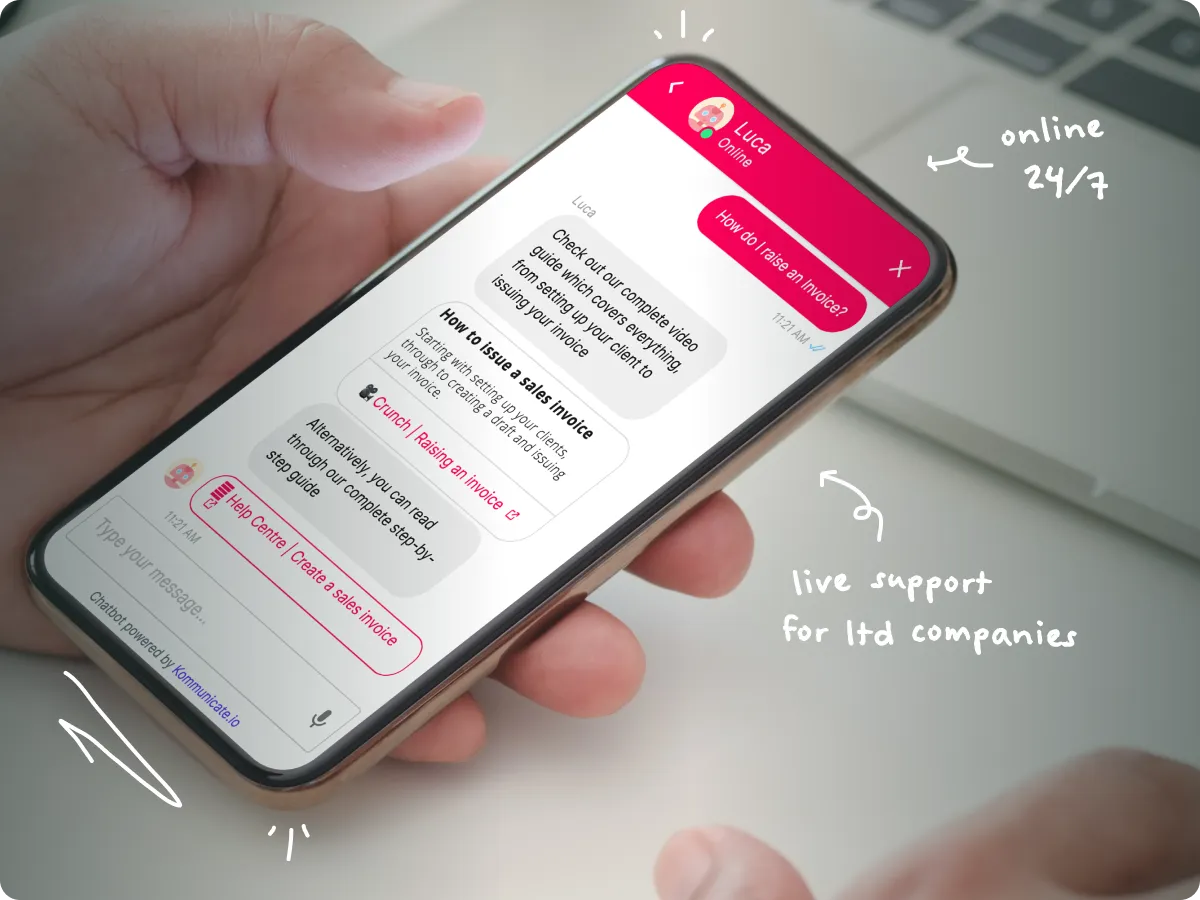We’re fast approaching the end of the tax year on 5th April, and now is usually a good time to get to grips with any tax changes, so you can maximise your tax efficiency for the outgoing tax year and get your business prepared for the new tax year.
You’ll also want to stay up-to-date with the relevant tax rates and thresholds.
Read on for help with getting ready for the end of the 2022/23 tax year and getting ready for the new tax year 2023/24 which starts on 6th April – We held our end of tax year webinar in March which you can check out on our Crunch YouTube channel to get the full rundown on what you should be doing to maximise your tax-efficiency. You can also download our webinar presentation or our ST > Ltd crossover help sheet.
The situation can be different depending on whether you’re a limited company director or a self-employed sole trader, we’ve covered both here.
Limited company directors
What is the end of tax year
The end of tax year is when your current tax year allowance finishes, and then restarts in the next tax year. Your tax code will refresh if you’re employed, and you’ll need to submit your tax return by this date if you’re self-employed. If you have an ISA, you’re given a tax-free allowance on your ISA amount each tax year, so when the tax year ends and a new one begins, this tax-free allowance will start again.
When is the end of tax year
The 2022/23 tax year ran from the 6th of April 2022 until the 5th of April 2023. The 2023/24 tax year will run from the 6th of April 2023 until the 5th of April 2024.
Make sure you take company dividends before 5th April 2023
It’s vital that any dividends you wish to take from company profits are issued by your company before 5th April 2023 to be included in your personal Self Assessment with HMRC for the 2022/23 tax year. This will help maximise your tax-efficiency by fully utilising your personal tax-free allowances and HMRC tax thresholds when combined with any director salary you take.
The tax-free Dividend Allowance of £2,000 has not changed for a number of years but will be falling to £1,000 from 6 April 2023. The Personal Allowance and tax thresholds affect the amount of tax you’ll pay on any dividends you take. The 2023/24 and 2022/23 rates and thresholds are shown below.
Note: The dividend basic and higher rate amounts assume all of the Personal Allowance is utilised.
Speaking of income tax, you can check out our tax rates and thresholds article for more information on the income tax rates.
How much can I take in dividends for the 2022/23 tax year?
Tax-free dividends
For the 2022/23 tax year, provided your only personal income before dividends is a salary of £9,100, which is the 2022/23 tax year National Insurance (NI) secondary threshold, then you can take up to £5,470 in dividends tax-free. This is calculated as follows and means your total tax-free income is £14,570 (£9,100 salary plus £5,470 in dividends).
Basic Rate threshold and tax - 2022/23 tax year
The Basic Rate tax threshold for the 2022/23 tax year is £50,270. If you have taken £14,570 in a combination of tax-free salary and dividends (see above), you can issue further dividends of £35,700 and remain within the basic rate threshold of £50,270. These dividends will be taxed at 8.75%. The total dividends issued will be £41,170 (£5,470 tax-free plus £35,700 at the basic rate of tax).
Higher Rate threshold and tax - 2022/23 tax year
The Higher Rate tax threshold is £150,000. However, when your income is above £100,000, your personal tax-free allowance is reduced by £1 for each additional £2 you earn above £100,000. Your tax-free allowance is therefore removed completely when your income is £125,140. Having issued dividends of £41,170, to reach the basic rate threshold, you can issue further dividends of £99,730 and still remain within the higher rate threshold. These dividends will be taxed at 33.75%. The total dividends issued will be £140,900.v
Additional Rate of tax - 2022/23 tax year
Once your total income is above £150,000 then further dividends will be taxed at 39.35%.
If you have other sources of income, such as rental income or dividends from other companies, then you will reach the threshold limits more quickly and more tax may be due. You should speak to your Crunch client managers if you’re unsure about any of this.
Make sure your records are up to date
When issuing dividends, it’s important to make sure that your accounting records are up to date, so that you only issue dividends from company profits after Corporation Tax has been accounted for. For users of cloud software, such as Crunch, you need to make sure all your transactions have been uploaded from your business bank account and that you’ve reconciled your Crunch software, with all expenses, pension contributions, salaries, and sales invoices which have been issued to your clients.
Once your software, or records, are up to date you’re able to make an accurate assessment of your company profits and any Corporation Tax due. You can then calculate the dividend you can pay yourself and other shareholders. Your Crunch software will automatically show this for you.
Don’t forget that any dividends must be paid from available company profits. If you take more than is allowed, you could face penalties and interest as it’s treated as a Director Loan.
Payroll deadlines and submissions
If you’re running payroll, even if it’s just for you as a single director/employee, then you mustn’t forget to file your final Full Payment Submission (FPS). This is an HMRC Real Time Information (RTI) requirement and you could face a £100 fine if you don’t file your end of year Full Payroll Submission (FPS) by 5th April 2023.
If you’re a Crunch client then further details on how to do this in the Crunch system can be found in our Final Payroll Submission Help Centre article.
You should record a payroll run for March 2023 to maximise your tax-efficient salary, if you have no other sources of income, this would mean paying yourself up to the NI threshold of £9,100 for the 2022/23 tax year. It’s therefore worth checking the amount of salary you have been paid in the tax year to date (since 6th April 2022).
For Crunch clients, from 6th March 2023, you can record your final payroll run for the tax year. You will receive full instructions on what to do in an email from your client managers, or you can read our FPS article in the Help Centre.
Year End responsibilities for directors
With many limited companies choosing to have 31st March as their financial year end, it can be a daunting undertaking for first-time limited company directors, but with our comprehensive year end checklist you’ll know exactly what you need to do.
Sole Traders
Getting ready for the end of tax year as a sole trader
Sole traders have it slightly easier as they don’t need to worry about dividends or payroll and RTI filing (unless they have any employees). We’d still always recommend you make sure that you’ve issued all your invoices and recorded all your expenses, so that when it’s time to file your Self Assessment for the 2022/23 tax year everything is ready.
If you’re a Crunch Sole Trader Accountancy client this should be simple, and once the new tax year starts you could file your Self Assessment straight away, unless you need to wait for any paperwork for any other sources of income you may have.
Whether you’re a limited company director, or a sole trader, there are a few more things you need to think about.
{{pt-self-assessment}}
Limited company directors, or sole traders
Maximise your pension contributions
If you want to make pension contributions this year, you need to make sure these payments are received by your pension provider by 5th April 2023.
If you run a limited company then making payments through your limited company is usually more tax-efficient. You can also pay into your pension through your monthly payroll or make lump sum contributions periodically throughout the tax year.
As a sole trader you just need to pay directly to your pension provider.
The total amount that can be contributed per year and still be tax-free is £40,000. Up to that limit, the government provides tax relief at the basic rate of 20% and this is added to your contributions by your pension provider.
If you are a higher rate taxpayer, you can claim further tax relief through your annual Self Assessment return. You are allowed to include the full £40,000 amount on your Self Assessment and the government will provide further tax relief of 20% (if you pay tax at the higher rate of 40%). So you claim back £8,000 from the government through your annual Self Assessment.
Don’t miss out on Pension Tax relief
If you’re a higher rate taxpayer, and you make contributions personally, your pension pot can be topped up by £1,000 and it would cost you £600 after tax relief. As a basic rate taxpayer, your pension pot can be topped by £1,000 and it costs you £800.
Don’t forget your annual ISA allowance
While you’re thinking of future investments, you may want to check if you could make any payments into an ISA or other tax-efficient savings which also have limits on what you can pay in each tax year.
Please speak to your financial advisor for more information and bespoke advice. If you don’t have an advisor then we can help. Find out more about Investments and Pensions advice.
What changes will there be from 6th April 2023?
The government is introducing some important changes to the following:
- National Insurance contribution threshold and rate changes
- UK Income tax threshold changes
- Scottish tax rate and income tax thresholds changed
- Changes to Student Loan deductions thresholds
- Capital gains allowance changes
We’ve put together an article with the highlights from the 23rd March 2022 Spring Statement.
Need some more help?
All of the above comments are for your information only. We always recommend speaking to an accountant for a more in-depth analysis of your circumstances. If you don’t have an accountant or are looking to switch, give our friendly team a call on 0333 920 0950 or arrange a free consultation.
.svg)









